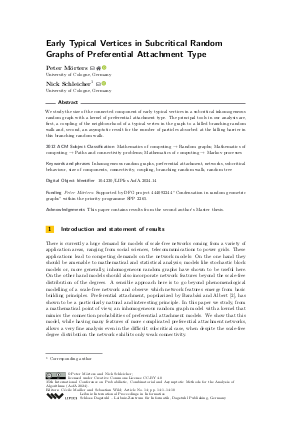@InProceedings{morters_et_al:LIPIcs.AofA.2024.14,
author = {M\"{o}rters, Peter and Schleicher, Nick},
title = {{Early Typical Vertices in Subcritical Random Graphs of Preferential Attachment Type}},
booktitle = {35th International Conference on Probabilistic, Combinatorial and Asymptotic Methods for the Analysis of Algorithms (AofA 2024)},
pages = {14:1--14:10},
series = {Leibniz International Proceedings in Informatics (LIPIcs)},
ISBN = {978-3-95977-329-4},
ISSN = {1868-8969},
year = {2024},
volume = {302},
editor = {Mailler, C\'{e}cile and Wild, Sebastian},
publisher = {Schloss Dagstuhl -- Leibniz-Zentrum f{\"u}r Informatik},
address = {Dagstuhl, Germany},
URL = {https://drops.dagstuhl.de/entities/document/10.4230/LIPIcs.AofA.2024.14},
URN = {urn:nbn:de:0030-drops-204493},
doi = {10.4230/LIPIcs.AofA.2024.14},
annote = {Keywords: Inhomogeneous random graphs, preferential attachment, networks, subcritical behaviour, size of components, connectivity, coupling, branching random walk, random tree}
}

 Creative Commons Attribution 4.0 International license
Creative Commons Attribution 4.0 International license
